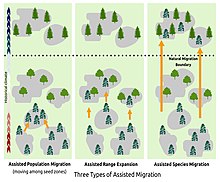
Assisted migration is "the intentional establishment of populations or meta-populations beyond the boundary of a species' historic range for the purpose of tracking suitable habitats through a period of changing climate...."[1] It is therefore a nature conservation tactic by which plants or animals are intentionally moved to geographic locations better suited to their present or future habitat needs and climate tolerances — and to which they are unable to migrate or disperse on their own.
In conservation biology, the term first appeared in publications in 2004.[2][3] It signified a type of species translocation[4] intended to reduce biodiversity losses owing to climate change. In the context of endangered species management, assisted colonization (2007)[5] and managed relocation (2009)[6] were soon offered as synonyms — the latter in a paper entailing 22 coauthors.[6][2]
In forestry science and management, assisted migration is discussed in its own journals and from perspectives different from those of conservation biologists. This is, in part, because paleoecologists had already concluded that there were significant lags in northward movement of even the dominant canopy trees in North America during the thousands of years since the final glacial retreat.[7][8][9][10] In the 1990s, forestry researchers had begun applying climate change projections to their own tree species distribution modelling efforts, and some results on the probable distances of future range shifts prompted attention.[11] As well, translocation terminology[12] was not controversial among forestry researchers because migration was the standard term used in paleoecology for natural movements of tree species recorded in the geological record. Another key difference between forestry practices and conservation biology is that the former, necessarily, was guided by "seed transfer guidelines" whenever a timber or pulp harvest was followed up by reforestation plantings. The provincial government of British Columbia in Canada was the first to update their guidelines with, what they call, "climate-based seed transfer."[13][14]
Overall, debate concerning the ethics of assisted migration in forestry practice was both short-term and muted[15][16] compared to that which prevails in conservation biology.[17][18][15][16] For this reason, a separate Wikipedia page titled Assisted migration of forests in North America was launched in 2021 and made into a useful teaching tool for climate adaptation education and decision-making in the forestry profession.
The remainder of this page therefore focuses on the topic of assisted migration in conservation biology and especially its applications for management of endangered species.
- ^ Allaby, Michael (2010). A Dictionary of Ecology. Oxford University Press. p. 31. ISBN 9780199567669. Retrieved 15 December 2022.
- ^ a b Barlow, Connie. "Assisted Migration or Assisted Colonization: What's In a Name?: Chronological History of the Debate on Terminology". Torreya Guardians. Retrieved 15 December 2022.
- ^ "Wild Earth Forum: Assisted Migration for an Endangered Tree" (PDF). Wild Earth. Winter 2004. Retrieved 15 December 2022.
- ^ IUCN (2013). Guidelines for Reintroductions and Other Conservation Translocations (PDF). ISBN 978-2-8317-1609-1.
- ^ Cite error: The named reference
Hunterwas invoked but never defined (see the help page). - ^ a b Richardson, David M; et al. (June 2009). "Multidimensional evaluation of managed relocation". Proc Natl Acad Sci. 106 (24): 9721–9724. doi:10.1073/pnas.0902327106. PMC 2694035. PMID 19509337.
- ^ Davis, Margaret B (October 1989). "Lags in vegetation response to greenhouse warming" (PDF). Climatic Change. 15 (1–2): 75–82. Bibcode:1989ClCh...15...75D. doi:10.1007/bf00138846. S2CID 154368627.
- ^ Davis, Margaret B; Shaw, Ruth B (27 April 2001). "Special Reviews: Range shifts and adaptive responses to Quaternary climate change". Science. 292 (5517): 673–679. Bibcode:2001Sci...292..673D. doi:10.1126/science.292.5517.673. PMID 11326089.
- ^ Petit, Remy J; et al. (August 2004). "Review: Ecology and genetics of tree invasions: from recent introductions to Quaternary migrations". Forest Ecology and Management. 197 (1–3): 113–137. doi:10.1016/j.foreco.2004.05.009.
- ^ Seliger, Benjamin J; McGill, Brian J; Svenning, Jens-Christian; Gill, Jacqueline L (November 2020). "Widespread underfilling of the potential ranges of North American trees". Journal of Biogeography. 48 (2): 359–371. doi:10.1111/jbi.14001. S2CID 228929332.
- ^ Aitken, Sally N; Yeamam, Sam; Holliday, Jason A; Wang, Tongli; Curtis-McLane, Sierra (25 January 2008). "Adaptation, migration or extirpation: Climate change outcomes for tree populations". Evolutionary Applications. 1 (1): 95–111. doi:10.1111/j.1752-4571.2007.00013.x. PMC 3352395. PMID 25567494.
- ^ Halleaux, Savannah (6 April 2023). "Traveling trees: Assisted migration for climate resilience". U.S. Forest Service. Retrieved 12 April 2023.
- ^ "Climate-based seed transfer". Managing our forest resources. British Columbia government. Retrieved 19 December 2022.
- ^ McKenney, Dan; Pedlar, John; O'Neill, Greg (March 2009). "Climate change and forest seed zones: Past trends, future prospects and challenges to ponder". The Forestry Chronicle. 85 (2): 258–266. doi:10.5558/tfc85258-2.
- ^ a b Pedlar, John H; et al. (September 2012). "Placing Forestry in the Assisted Migration Debate". BioScience. 62 (9): 835–842. doi:10.1525/bio.2012.62.9.10.
- ^ a b Williams, Mary I; Dumroese, R Kasten (4 July 2013). "Preparing for Climate Change: Forestry and Assisted Migration". Journal of Forestry. 111 (4): 287–297. doi:10.5849/jof.13-016.
- ^ Grandoni, Dino (15 September 2024). "These birds are almost extinct; a radical idea could save them". Washington Post.
- ^ Brodie, Jedediah F; et al. (30 April 2021). "Policy Forum: Global policy for assisted colonization of species". Science. 372 (6541): 456–458. doi:10.1126/science.abg0532. PMID 33926936. S2CID 233448828.